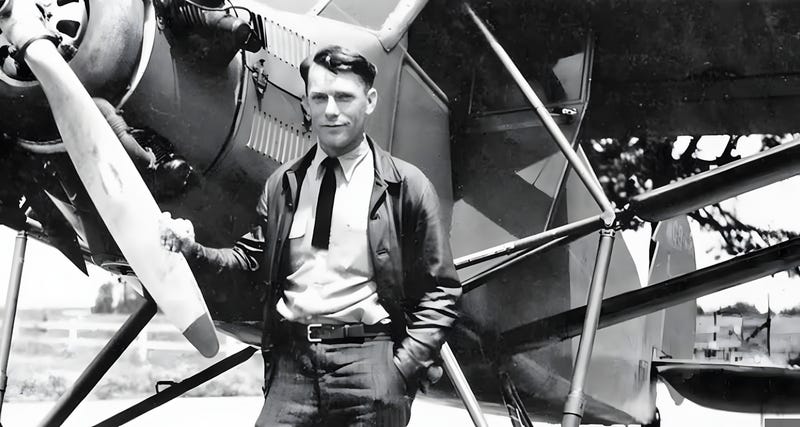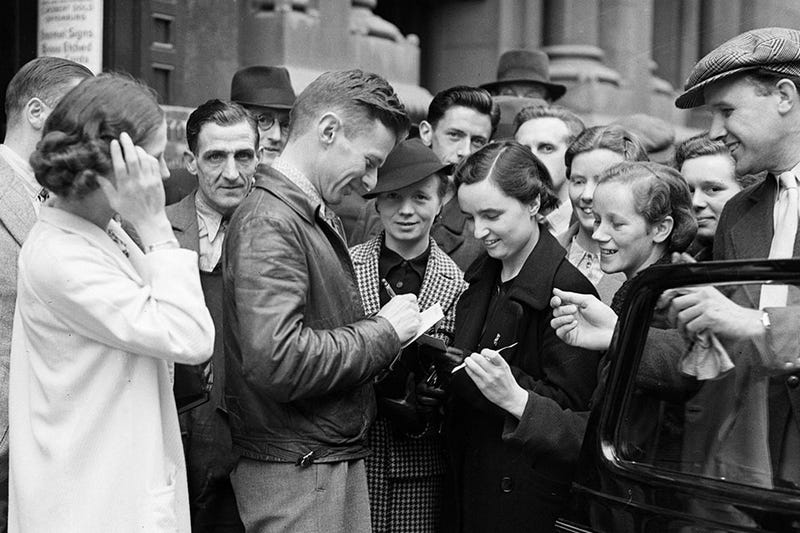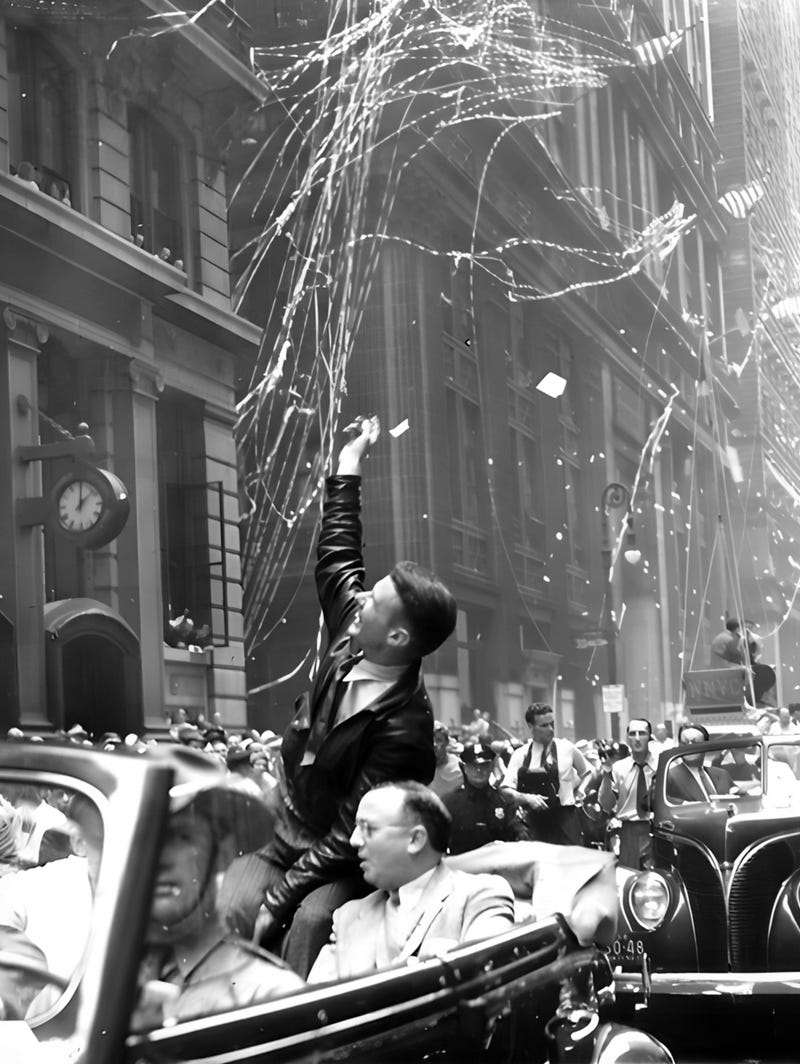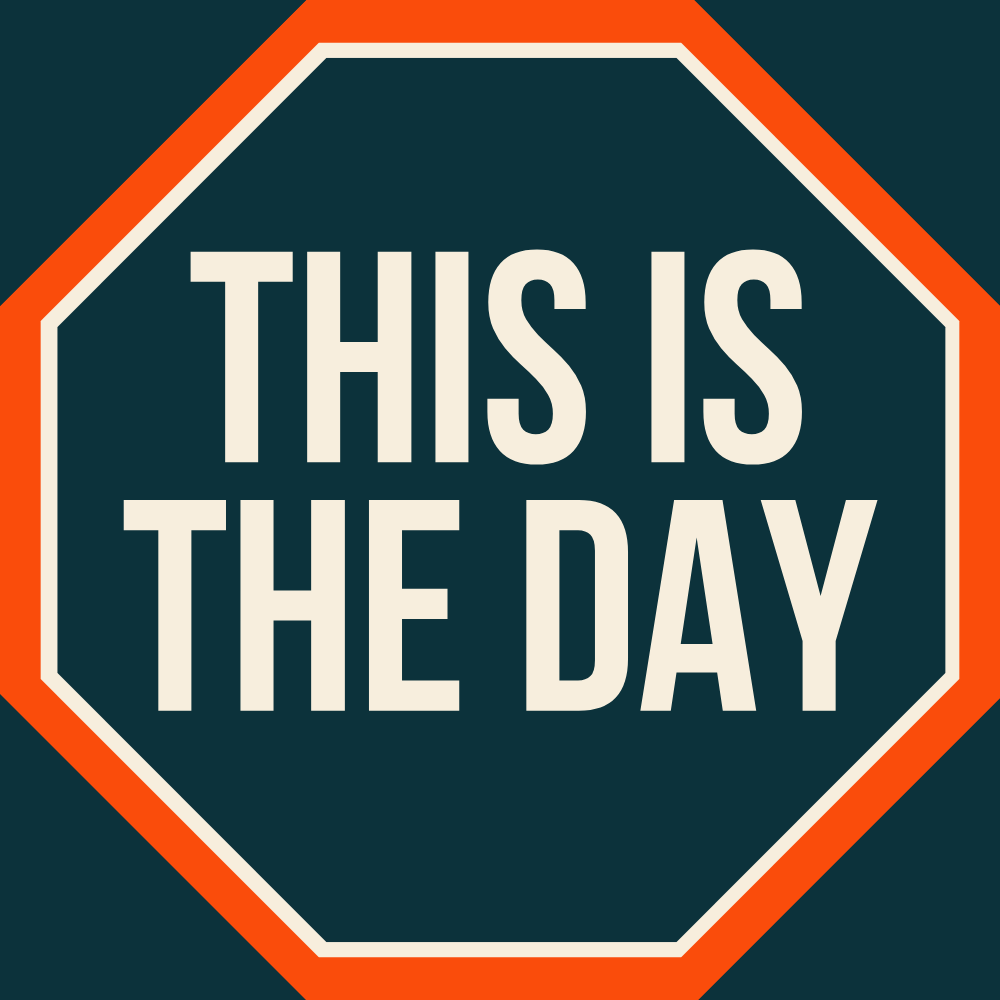July 17 - How Getting Lost Made “Wrong Way” Corrigan a National Hero
Creative Obedience Over Clever Rebellion
This is the day Douglas "Wrong Way" Corrigan took off from Brooklyn's Floyd Bennett Field on what became aviation's most famous "navigational error" in 1938.
In today's lesson, we will explore how Douglas Corrigan's "accidental" flight to Ireland became a masterclass in holy mischief—and what it teaches us about the tension between clever disruption and faithful obedience. When does a wink become a tool of truth, and how do we distinguish between Spirit-led creativity and mere rebellion against authority?

"At noon Elijah began to taunt them. 'Shout louder!' he said. 'Surely he is a god! Perhaps he is deep in thought, or busy, or traveling. Maybe he is sleeping and must be awakened.'" - 1 Kings 18:27 (NIV)
This Date in History
Douglas Corrigan gripped the controls of his battered 1929 Curtiss Robin monoplane as he taxied down the runway at Floyd Bennett Field in Brooklyn, New York, just after dawn on July 17, 1938. The 31-year-old Irish-American pilot had filed a flight plan for Long Beach, California. Twenty-eight hours later, he would land in Dublin, Ireland, step out of his cockpit with a grin, and according to reports, ask Irish officials something like, "Just got in from New York. Where am I?"
No one believed it was an accident. And that was exactly the point.
Corrigan's story began eleven years earlier when he worked as a mechanic helping to prepare Charles Lindbergh's Spirit of St. Louis for its historic 1927 transatlantic crossing. Watching Lindbergh achieve immortal fame sparked a dream in the young Texan that would consume the next decade of his life. But by the late 1930s, transatlantic flight had become heavily regulated, and Corrigan's repeated applications to the U.S. Bureau of Air Commerce for permission to fly to Ireland were consistently rejected.
The government's reasoning was sound. Corrigan's aircraft looked like it belonged in a scrapyard rather than attempting oceanic crossings. He had purchased the nine-year-old Curtiss Robin for $310 and spent years modifying it with surplus parts, tin-can fuel tanks, and creative engineering that would make any safety inspector nervous. His modifications included extra fuel tanks that filled most of the cabin space and severely compromised forward visibility, forcing him to navigate by sticking his head out the side window when necessary. His compasses were reportedly unreliable, though some historians suspect they worked fine and were simply part of his elaborate performance.
After years of rejections, Corrigan changed tactics. Though officials had long considered his aircraft unfit for overseas travel, in July 1938 he filed a perfectly legitimate flight plan for a transcontinental journey to California. Aviation officials approved the domestic flight, and Corrigan nodded politely, assuring them he understood the restrictions completely.
On the morning of July 17, witnesses at Floyd Bennett Field watched something peculiar. After receiving clearance for his westbound flight to California, Corrigan's plane turned east toward the Atlantic Ocean instead of west toward the American continent. When questioned later, Corrigan claimed that thick clouds and his faulty compass had confused his navigation. He insisted he had been flying toward California when the weather cleared and he was shocked to see an ocean instead of the American landscape he expected.
The flight itself was harrowing. For 28 hours and 13 minutes, Corrigan battled icy conditions, low oxygen levels, and a leaking gas tank while flying through fog so thick he could barely see his instruments. When he finally spotted land and touched down at Baldonnel Aerodrome near Dublin, Irish authorities greeted him like a conquering hero. Here was a pilot who had accomplished what his own government said was impossible, using nothing but determination, mechanical ingenuity, and perhaps a healthy disregard for bureaucratic restrictions.
The contrast in receptions couldn't have been starker. While the Irish celebrated his achievement with enthusiasm, American officials were decidedly less amused. When Corrigan returned to the United States aboard the S.S. Manhattan, he was met with a 30-day suspension of his pilot's license for violating his approved flight plan. The government's heavy-handed response only enhanced his folk hero status.
But the American public had already claimed him as their own. In the depths of the Great Depression, "Wrong Way" Corrigan offered something precious: a light-hearted underdog story about a scrappy individual who had outsmarted bureaucracy with a wink and a smile. New York City honored him with a ticker-tape parade down Broadway, and he received offers for movie deals, endorsements, and speaking engagements. His deadpan insistence that the entire adventure was just a navigational mistake only added to his charm and the public's fascination with his achievement.
Whether Corrigan's "wrong turn" was genuinely accidental or brilliantly calculated remains one of aviation's great mysteries. What's certain is that in 28 hours, he had accomplished what months of official applications couldn't achieve: recognition as a serious aviator and proof that sometimes the best way to follow your dreams is to get creatively lost on the way to somewhere else.

Historical Context
In 1938, the aviation industry was still recovering from the regulatory upheaval that followed a series of high-profile crashes earlier in the decade. The Air Commerce Act of 1926 had established federal oversight of aviation, but by the mid-1930s, public confidence in air travel had been shaken by accidents involving mail pilots and commercial airlines. The government response was increased regulation and stricter enforcement of flight safety standards, making unauthorized flights across international borders virtually impossible for private pilots.
The broader economic landscape of 1938 made Corrigan's story even more compelling to Depression-weary Americans. The country was experiencing what economists now call the "Roosevelt Recession," a sharp economic downturn within the larger Great Depression that saw unemployment spike back toward 20 percent. Against this backdrop of economic hardship and expanding government control, Corrigan represented the kind of individual initiative and rule-bending resourcefulness that many Americans admired but felt increasingly unable to exercise in their own lives. His success in circumventing bureaucratic obstacles resonated with a public that felt constrained by both economic circumstances and growing federal oversight of daily life.

Did You Know?
Corrigan's ticker-tape parade in New York City was actually larger than Charles Lindbergh's famous celebration, with over one million New Yorkers lining Broadway to cheer for the "Wrong Way" pilot who had thumbed his nose at authority.
The leaking gas tank in Corrigan's modified Curtiss Robin was so severe that he had to cut a hole in the cockpit floor during the flight to let the fumes drain out, preventing him from either passing out or going up in flames.
Corrigan quickly capitalized on his fame by endorsing "wrong way" products, including a wristwatch that ran counter-clockwise, and wrote his autobiography That's My Story within months of the flight, publishing it just in time for Christmas sales in 1938.
The $75,000 Corrigan earned from starring as himself in the 1939 Hollywood film The Flying Irishman was equivalent to 30 years of income at his typical airfield mechanic jobs, making him wealthy practically overnight.
Charles Lindbergh himself wrote a friendly four-page handwritten letter to Corrigan in 1939, acknowledging his accomplishment after Corrigan sent him a copy of his autobiography, showing that even aviation's biggest celebrity respected the audacious flight.
Today’s Reflection
Douglas Corrigan stepped out of his rickety Curtiss Robin at Baldonnel Aerodrome near Dublin, grinned at the Irish officials, and delivered one of aviation's most audacious performances: "Just got in from New York. Where am I?"
The authorities weren't buying it. Neither was anyone else. And that was exactly the point. But not the whole point. Corrigan's journey wasn't just a stunt; it was a protest wrapped in a smile, a quiet challenge to a system so entangled in red tape that it had forgotten the power of human ingenuity and vision.
At first glance, it looks like rebellion. But under the surface lay years of patience, preparation, and a longing to do something good and meaningful. His "wrong turn" may not have come with a divine commissioning, but it reflected a principle we often see in Scripture: when systems become so closed off to truth that they block out wisdom and justice, God sometimes raises up voices—and even actions—that cut through the noise.
Sometimes profound acts of purpose can masquerade as mischief. Sometimes God uses a wink to restore truth.
Corrigan's "wrong turn" wasn't rebellion for rebellion's sake. It was purposeful disruption of a system that had grown so rigid, so bureaucratic, that honest intent could no longer find a hearing. His flight looked like defiance, but underneath lay years of patient preparation and a dream consistently dismissed by those in power.
The wink in Corrigan's case wasn't meant to ridicule truth but to expose the absurdity of a system that valued paperwork over possibility.
This pattern echoes throughout Scripture, where God's servants sometimes employ holy mischief to cut through human obstinacy and redirect attention to divine truth.
"At noon Elijah began to taunt them. 'Shout louder!' he said. 'Surely he is a god! Perhaps he is deep in thought, or busy, or traveling. Maybe he is sleeping and must be awakened.'" 1 Kings 18:27 (NIV)
Elijah's sarcasm on Mount Carmel wasn't cruel entertainment. It was surgical precision designed to expose the ridiculous futility of idol worship.
While the prophets of Baal worked themselves into a frenzy, cutting themselves and crying out to deaf stone, Elijah's pointed humor revealed the obvious truth that Israel had somehow forgotten: their "gods" couldn't even wake up, much less send fire from heaven.
The Hebrew midwives used Spirit-led cleverness to preserve life when Pharaoh commanded them to kill the Hebrew boys. Their claim that Hebrew women were too vigorous to wait wasn't deception for selfish gain—it was a courageous stand taken in reverence for life and in faithfulness to God. Their "excuse" saved countless lives and earned God's blessing. Scripture affirms this by noting that God blessed them for their actions.
Even Jesus wielded irony as a tool of truth. When the Pharisees criticized His disciples for plucking grain on the Sabbath, He reminded them that David ate consecrated bread in the temple. When the Pharisees tried to trap Him over taxes, He asked whose image was on the coin, then offered a brilliant answer that lifted the conversation beyond legalism into spiritual accountability: "Give back to Caesar what is Caesar's, and to God what is God's." Matthew 22:21 (NIV)
His wit consistently outmaneuvered their attempts at entrapment while pointing them back to deeper spiritual realities. His words didn't just deflect their traps—they exposed their shallow understanding of God's kingdom.
But here's the tension: holy mischief is never about ego or anarchy. It's not cleverness for its own sake. True holy mischief is a form of obedience. It's Spirit-led disruption designed to re-center attention on God's truth when conventional methods have failed.
The wink only becomes holy when it points people back to truth.
Corrigan's flight, while certainly not a biblical act, accomplished something that years of official applications couldn't: it demonstrated that bureaucratic obstruction sometimes stifles the very innovation and courage a nation needs. His "mistake" reminded Depression-era Americans that individual initiative and creative problem-solving still mattered, even when systems seemed designed to crush both.
But we must be careful. Not every act of clever defiance qualifies as what I've been calling "holy mischief."
The difference lies in the heart's motivation and the outcome's direction. Are we serving ourselves or serving God? Are we drawing attention to our own cleverness or pointing others toward divine truth? Are we solving problems or simply creating chaos?
When systems grow so rigid they can no longer respond to righteous purpose, God sometimes calls His people to creative disruption. But this calling requires discernment, courage, and complete surrender to His will rather than our own desire to be clever.
The question isn't whether we can outsmart the system. The question is whether God is calling us to speak—or act—in a way that challenges injustice while remaining rooted in humility, discernment, and love.
Holy mischief, when it is truly holy, always draws us back to God's heart. It rekindles wonder not in ourselves, but in the One who turns the wisdom of the world upside down.
Practical Application
Before speaking or acting in ways that challenge established systems, spend time in prayer asking God to reveal whether your motivation stems from frustration with injustice or simply frustration with inconvenience. Examine whether your proposed action would draw attention to God's truth or to your own cleverness, and consider whether the outcome would serve His kingdom or your ego. Practice discerning the difference between holy disruption and mere rebellion by studying biblical examples like Elijah's confrontation with false prophets, the Hebrew midwives' protection of Hebrew babies, and Jesus's temple cleansing, noting how each action served to restore truth rather than destroy order for its own sake.
Closing Prayer
Heavenly Father, we thank You for Your servants throughout history who have had the courage to challenge systems that stood in opposition to Your truth and justice. We confess that too often we mistake our own frustration for righteous indignation, seeking to be clever rather than faithful. Give us the discernment to recognize when You are calling us to speak boldly and act decisively, and the wisdom to distinguish between holy mischief that serves Your kingdom and mere rebellion that serves our pride. Help us to follow the example of Elijah, who used pointed truth to expose falsehood, and of Jesus, who disrupted corruption to restore righteousness. May any wit we employ and any creative solutions we pursue always point others toward Your truth rather than our own intelligence. Transform our desire to outsmart the world into a passion for serving Your purposes, knowing that true wisdom comes from You alone. In Jesus' name, we pray. Amen.
Final Thoughts
True holy mischief operates in the tension between a wink and wonder—using wit and creativity not to diminish the sacred, but to cut through the clutter that obscures it. When systems become so rigid they can no longer serve justice or truth, God sometimes calls His people to disruptive obedience that challenges the status quo while remaining rooted in love and humility. The key is ensuring our clever solutions serve His kingdom rather than our ego, always pointing others toward the One who transforms hearts and changes the world through those willing to be faithful rather than simply clever.
Also On This Date In History
July 17 - Operation Little Vittles: A Sweet Mission During the Berlin Airlift
This is the day US Air Force pilot Gail Halvorsen meets children at Tempelhof Airport, inspiring the candy drops of 'Operation Little Vittles' during the 1948 Berlin Blockade.
Author’s Notes
Update for everyone who’s been praying for me after my eye surgery:
I had a checkup yesterday, and I’m grateful to report that my eyes are healing, according to the doctor. That was reassuring, since I’ve been concerned—my vision still isn’t clear enough for something as basic as driving.
The main issue now is that my eyes are extremely dry, which is significantly slowing the healing process. My doctor prescribed some new eye drops that recently hit the market and are supposed to help, but she said it may still be several weeks before I notice any real improvement.
So while there’s nothing technically wrong, I’d definitely prefer to be ahead of schedule in healing—not behind it.
Thanks again for your prayers and support. They mean a lot, and I’d be grateful if you’d continue.
If you’ve made it this far down the page can you do me a favor? Let me know what you thought about today’s newsletter. Leave a comment or like (❤️) this post. I would really appreciate it.










Jason, it’s good to hear that you are on the mend. My wife just had her first cataract surgery yesterday and so far she appears to be doing well. Next week she gets the other eye done.
I’m not a doctor nor do I play one on TV but my eye doctor strongly recommended that I use krill oil to relieve my dry eyes. I was shocked that he didn’t write any prescriptions and that gave me a lot of trust in him. I have friends who are on 2 or 3 prescriptions for dry eyes!
Have a great and blessed day!
Love this: “ …the best way to follow your dreams is to get creatively lost on your way to somewhere else.” And I believe we could all use a bit more “holy mischief” in our lives!